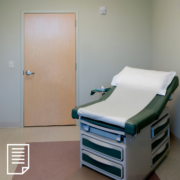Breast Cancer Research News: SABCS Conference Highlights
Breast Cancer Research News: SABCS Conference Highlights from Patient Empowerment Network on Vimeo.
Expert Dr. Megan Kruse shares highlights from the 2020 San Antonio Breast Cancer Symposium (SABCS). Dr. Kruse provides an overview of what this news means for early stage breast cancer patients, along with her optimism about the future of breast cancer research and treatment.
Dr. Megan Kruse is a Breast Medical Oncologist at the Cleveland Clinic. More about this expert here.
See More From The Pro-Active Breast Cancer Patient Toolkit
Related Resources:
Transcript:
Dr. Kruse:
The San Antonio Breast Cancer Symposium is a national meeting with international presence that combines all of the latest data from research on breast cancer topics. It involves clinical research, basic science research, a lot of patient, and patient advocate support.
And the idea here is to bring together all the different disciplines that are involved in breast cancer patient care and do the best information and knowledge sharing that we can each year.
This year’s San Antonio Breast Cancer Symposium brought us a lot of interesting research focusing on early-stage breast cancer patients. I think the most important presentations that were given had to do with the treatment of high-risk lymph node-positive hormone receptor-positive breast cancer patients. And these were really across three abstracts. The first abstract of interest was the Monarch E study, which looked at high-risk women with hormone receptor-positive HER2-negative breast cancer and optimizing their medical therapy.
So, these patients are typically treated with anti-estrogen therapy and the idea of the research that was presented was if the addition of a targeted medication called abemaciclib or Verzenio could help to improve outcomes for women in this population. And what the trial found was that for women who took their anti-estrogen therapy for the usual length of time but added the abemaciclib for the first two years of that anti-estrogen therapy that there is actually an improvement in cancer-free survival time or an improvement in cure rates. And this was important because these women may not benefit from chemotherapy, as we’ll talk about in another abstract.
An addition research presentation that was given that goes alongside of the monarch E study was that of the Penelope B study. And the Penelope B took a similar population to what was studied in Monarch E. So, again high-risk women with lymph node-positive, hormone receptor-positive, HER2-negative breast cancer; however, in Penelope B, all of these patients had received pre-surgery chemotherapy.
And in order to qualify for the trial, the patients had to have some cancer that remained in the breast or the lymph nodes that was taken out at the time of their surgery. So, these are patients clearly in which chemotherapy did not do the whole job in terms of getting rid of the cancer. And again, the idea here was to add a second targeted therapy to the endocrine therapy to see if that would improve cancer-free time for patients in this population. The difference in this study was that the partner targeted therapy that was used was a drug called palbociclib or Ibrance.
And the drug was actually only used for one year in combination with endocrine therapy rather than two years as was used in the Monarch E study with abemaciclib. Interestingly enough, the Penelope B study was a negative study, meaning that it did not improve the cancer-free survival time for women who took the endocrine therapy plus targeted therapy compared to women who took the endocrine therapy alone.
So, I think that these are two interesting studies that one should look at together. And clearly, may impact what we do for the treatment of high-risk hormone receptor-positive women moving forward. The third abstract that I’d like to touch on that I think was important for women with early-stage breast cancer is the RxPONDER study, also known as SWOG 1007. And this study again was looking at lymph node-positive, hormone receptor-positive HER2-negative breast cancer patients and seeing if the addition of chemotherapy helped to improve their cancer-free survival compared to anti-estrogen therapy alone.
And so, in this study, while the study population was all women with early-stage breast cancer, meeting the one to three lymph node-positive criteria, you really have to break the results down into the results for pre-menopausal women and the results for post-menopausal women.
Because overall the study really showed no significant benefit to chemotherapy on top of endocrine therapy for women in this population; however, we did see that there was a clear benefit for women who were pre-menopausal. So, the women who had no benefit from chemotherapy were largely those who were post-menopausal, while those who were pre-menopausal derived extra benefit from chemo on top of anti-estrogen therapy. And that benefit depended on what the Oncotype recurrent score was.
With women that had the lowest of the recurrent scores having a chemo benefit of about three percent going up to over five percent for women who had Oncotype recurrent scores in the mid-teens to 25 range. In both of these groups, women who had Oncotype scores of 26 or above would have chemotherapy as per our standard of care.
So, I think that this abstract is important because in the past women who had lymph node-positive breast cancer generally received chemotherapy no matter what. More recently we’ve understood that not all of these cancers are created equal and that some cancers may not actually have benefit from chemotherapy in terms of improving cure rate. So, this study is a big step forward to help individualize and specify the treatment for women with lymph node-positive, hormone receptor-positive, HER2-negative early breast cancer.
I’ve very hopeful about the research that is going to lead to new developments for breast cancer treatment in the next few years.
I think what we’ve seen both at this San Antonio Breast Cancer Symposium as well as other conferences in the recent past has been a lot of focus on finding the right treatment for the right patient at the right time. And so, patients seem to be very interested in finding out this information. They often come to clinic armed with the most recent data, which allows their providers to have really informed discussions about what the best treatment might be. And to talk about if the new treatments are not great right now, what treatments might look like in the future.
I think the other thing that’s encouraging about the research that we’ve seen presented at this conference is that some of these trials are very, very large. For example, the RxPONDER trial was a trial of over 9,000 patients. And I really think that’s amazing to get that many patients interested in research that may not directly impact their patient care but will impact the care of others moving forward.
It’s just a sign that our breast cancer patients are empowered, and they want to make a difference in the scientific community as a whole.












